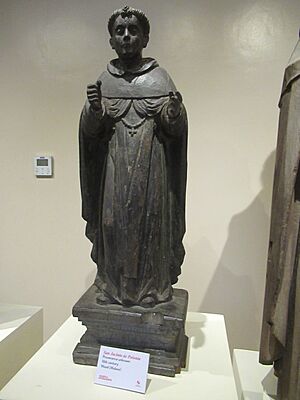Hyacinth of Poland facts for kids
Quick facts for kids SaintHyacinth OP |
|
|---|---|

Apparition of the Virgin to Saint Hyacinth, Ludovico Carracci (1592), in the Louvre Museum
|
|
| Confessor | |
| Born | c. 1185 Kamień Śląski, Silesia, Poland |
| Died | 15 August 1257 Kraków, Lesser Poland, Poland |
| Venerated in | Roman Catholic Church Aglipayan Church |
| Canonized | 17 April 1594 by Pope Clement VIII |
| Feast | 17 August |
| Attributes | Holding a statue of the Blessed Virgin Mary along with a monstrance or ciborium |
Hyacinth (also known as Jacek Odrowąż) was a Polish Dominican priest and missionary. He was born around 1185 and died on August 15, 1257. He worked to improve women's monasteries in his home country of Poland. He studied in important cities like Paris and Bologna and became an expert in religious studies.
Contents
Life of Saint Hyacinth
Hyacinth was born in 1185 in a castle called Lanka, in Kamień Śląski, Silesia, Poland. He came from a noble family called Odrowąż. He was a relative of another saint, Ceslaus.
He studied in famous cities such as Kraków, Prague, and Bologna. In Bologna, he earned a special title as a Doctor of Law and Divinity. When he returned to Poland, he received a church position in Sandomierz. This was an important city in the southeastern part of Poland.
Later, Hyacinth went to Rome with his uncle, Iwo Odrowąż, who was the Bishop of Kraków. In Rome, Hyacinth saw a miracle performed by Saint Dominic, the founder of the Dominican Order. This event inspired Hyacinth, and he decided to become a Dominican friar (a type of monk). His relative Ceslaus and two others also joined with him.
In 1219, Pope Honorius III invited Saint Dominic and his followers to live at an old Roman church called Santa Sabina. Hyacinth and his friends were among the first to live there. They also studied at the Dominican school in Santa Sabina.
After a short training period, Hyacinth and his companions officially became Dominicans in 1220. Saint Dominic himself gave them their religious clothes.
Spreading the Faith
The young friars were then sent back to their home countries. Their mission was to start the Dominican Order in Poland and Kyiv. As Hyacinth and his three friends traveled back to Kraków, he helped set up new monasteries. He appointed his companions as leaders of these new places.
Eventually, Hyacinth was the only one left to continue to Kraków. He traveled throughout Northern Europe, sharing his faith with many people. He died in 1257. Some stories say he also traveled to places like Sweden, Norway, Denmark, Prussia, Scotland, Russia, Turkey, and Greece. However, these long journeys are not fully confirmed by the earliest stories about his life.
Miracles and Legends

One of the most famous miracles linked to Hyacinth happened during the Mongol attack on Kyiv in 1240. As the friars got ready to escape the invading army, Hyacinth went to save the ciborium. This is a special container that holds the eucharist (holy bread) from the church's tabernacle.
While he was doing this, he heard the voice of Mary, mother of Jesus. She asked him to take her statue with him too. Hyacinth lifted the large, stone statue of Mary, along with the ciborium. He was able to carry both easily, even though the statue was much heavier than he could normally lift. This way, he saved both. Because of this story, he is often shown holding a monstrance (a container for the eucharist) and a statue of Mary.
Saint Hyacinth and Pierogi
In Poland, there is an old saying: Święty Jacku z pierogami! This means "St. Hyacinth and his pierogi!" People used it as a call for help in very difficult situations. This saying comes from two legends:
- One story says that on July 13, 1238, Hyacinth visited a town called Kościelec. A terrible hailstorm suddenly hit, destroying all the crops. This meant people would face poverty and famine. Hyacinth told them to pray. The very next day, the crops were magically restored! The grateful people then gave Hyacinth pierogi (dumplings) made from the saved crops.
- The second legend says Hyacinth fed people with pierogi during a famine. This famine was caused by the Mongol invasion of 1241.
Honoring Saint Hyacinth
The tomb of Saint Hyacinth is in the Basilica of Holy Trinity in Kraków, Poland. There is a special chapel there named after him.
Hyacinth was made a saint on April 17, 1594, by Pope Clement VIII. His special day is celebrated on August 17. In 1686, Pope Innocent XI named him a patron saint of Lithuania. He is also known as the patron saint of people in danger of drowning and for weight lifting.
In North America, one famous church dedicated to Saint Hyacinth is St. Hyacinth's Basilica in Chicago, Illinois.
See also
- Convent of Saint-Hyacinth, Fribourg
- St. Hyacinth Basilica
- Saint Hyacinth of Poland, patron saint archive


